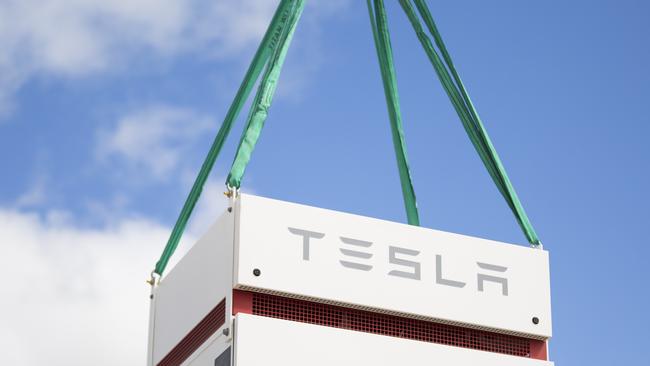Tesla charges power market with challenge to business
Tesla puts big power companies on notice it is coming for their business, as it flagged a ‘humungous’ battery in Victoria.

The $US400bn ($555bn) Tesla has put Australia’s biggest power companies on notice it is coming for their business, as chairman Robyn Denholm flagged the company’s ‘‘humungous’’ battery installation in Victoria would be “the size of a gas turbine”, pitting the US giant’s clean energy ambitions against fossil fuel.
Victorian Energy Minister Lily D’Ambrosio fired the latest salvo in the state’s energy wars with the Morrison government on Thursday, announcing that France’s Neoen will build one of the world’s biggest batteries, provided by Elon Musk’s Tesla, near Geelong.
The move is aimed at shoring up the state’s grid at the height of summer, raising doubts over the need for new gas peaking plants and a broader gas-fired economic recovery which has been pushed by the federal government.
Ms Denholm backed up Tesla’s battery win by flagging a further push into Australia’s energy space by the company, echoing comments by Mr Musk that its battery and energy division could one day be the biggest earner for the company, which is currently better known for its electric vehicles.
“Globally we’re seeing that batteries are really the key for renewable energy and are allowing renewables to replace gas and coal generation and deliver lower energy prices while improving grid reliability and lowering emissions for the environment,” Ms Denholm said.
“It is a significant project for Tesla in terms of proving out the size and scale of the batteries. It’s roughly the size of a gas turbine. So we’re taking that size and scale in terms of the battery that we’re delivering here,” she said.
Ms Denholm, is a former top-ranked Telstra executive, was appointed chairman of Tesla in 2018, taking over the role from Mr Musk.
Neoen will fund the estimated $250m capital cost of building the battery, and will be paid about $12.5m a year under a service contract with the Australian Energy Market Operator to have 250MW of its 300MW capacity available for use at AEMO’s direction.
Ms D’Ambrosio said its cost would effectively be added to the bills of Victoria households and businesses, but that its delivery was expected to drive down energy costs in the state.
“This is a humungous battery,” Ms D’Ambrosio said. “It’s basically what the future needs to look like and we’ve got to make it happen.”
Victoria has a renewable energy target of 40 per cent by 2025, and Ms D’Ambrosio said the new battery would assist in helping get more solar and wind energy into the state’s energy supply, and ease concerns about summer blackouts if higher temperatures push the state’s ageing coal-fired power stations beyond their operating limits.
While designed to help stabilise the Victorian grid and allow more renewable energy into the system, the battery will also undercut the case for gas peaking plants in the state, opening a new front in the ongoing dispute over energy policy between the Andrews government and its federal counterparts.
The Morrison government wants to use gas peakers to help back up the growing share of renewables in the electricity grid as part of a broader gas-led economic recovery blueprint.
Angus Taylor surprised some investors in late September after revealing its wholly owned Snowy Hydro business was developing options to build a 350MW gas generator in NSW if private investors failed to step up and build new supplies before AGL Energy’s Liddell coal unit closes.
Snowy then revealed it will also consider boosting the size of its two Victorian gas-fired power plants — the 320MW Laverton North gas plant and 300MW Valley Power gas power station — to aid growing clean energy generation.
Mr Taylor told The Australian on Thursday the federal government would continue to back the installation of grid-scale battery technology after offering money for smaller projects in NSW and WA.
But he said the government’s focus was on “long-duration storage”.
“Batteries are not a cost-competitive option to replace gas and hydro as firming for renewables, or coal as the provider of baseload power in Victoria,” he said.
Victoria recently changed its laws to allow it to intervene in the state’s energy markets through projects such as the battery, and its decision to go it alone on the project was also criticised by big energy generators.
Australian Energy Council, which represents the big three energy giants AGL, Origin and EnergyAustralia, said the decision to push ahead with the project without a review of its impact on power prices by the Australian Energy Regulator was a “bad idea”.
“The AEC supports private investment in response to market signals. However, this battery will be funded by Victorian consumers whether or not it proves useful. It is being developed under new legislation that allows the Victorian minister to direct such developments outside the national planning and regulatory framework. It will also impact private investment decisions made in good faith within that framework,” AEC chief executive Sarah McNamara said.
But in a thinly veiled shot at the federal government’s resistance to further large-scale renewable energy generation affecting the national energy market, Ms D’Ambrosio said Victoria could not afford to wait for regulators to catch up with technology.
“One of the reasons I was very keen to give us the powers in Victoria to do such projects as this is we need to have a degree of nimbleness. And we need the flexibility that, in the event that national systems don‘t work in our favour … on behalf of Victorian consumers … that we need to have that nimbleness to make decisions more quickly,” she said.
The deal is expected to create an initial 85 jobs with Neoen paying for the construction of the lithium-ion battery as well as ongoing operation and maintenance.
Additional reporting: Remy Varga





To join the conversation, please log in. Don't have an account? Register
Join the conversation, you are commenting as Logout